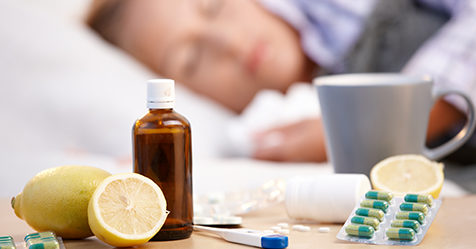Toxic. Harsh. Carcinogenic. Harmful. These are a few words often associated with volatile organic compounds (VOCs), but what exactly are these compounds?
VOCs are a large group of chemicals with high vapor pressure and low water solubility that are emitted as gases from certain solids and liquids. Many people think they are only associated with harsh products such as paint thinners and solvents. However, VOCs are emitted from numerous sources and products in our everyday lives, including building materials, furniture, air fresheners, dry cleaning processes, office printers, arts and crafts products, and permanent markers, according to the American Lung Association. They also lurk in thousands of common household and personal care products—especially cleaning products and disinfectants.
A recent study from the Environmental Working Group (EWG) found that many cleaning products, even some labeled “green,” release hundreds of VOCs that may impact human health. Exposure can cause adverse health effects including eye, nose, and throat irritation; headaches; nausea; and even long-term damage to the liver, kidneys, heart, and central nervous system. As some VOCs are proven carcinogens exposure to them can lead to cancer, according to the Indoor Air Quality Scientific Findings Resource Bank. Understanding what VOCs are, how they are emitted, and which products contain harmful ones can help reduce exposure in public spaces to protect everyone’s health.
Common VOCs in cleaning products
Cleaning and disinfectant products emit VOCs by a process called off-gassing. This process occurs when cleaning chemicals are released into the air by actions such as spraying, wiping, or simply using the product. VOCs evaporate quickly, making it extremely hard to avoid breathing them in. They also heavily pollute your indoor air, with concentrations often 10 times higher indoors than outdoors, according to the U.S. Environmental Protection Agency (EPA).
While the main route of VOC exposure is through inhalation, dermal absorption and ingestion can also occur. It’s important to always remember that what goes in a cleaning bottle can, and most likely will, enter the body. A research report from Women’s Voices for the Earth (WVE) revealed the most problematic and pervasive ingredients found in numerous cleaning products. Cleaning products that emit these toxic VOCs include air fresheners, bleach products, single-use disinfectant wipes, detergents, dishwashing products, furniture, floor polish, and oven cleaners, according to the American Lung Association. These chemicals are often added to enhance product performance, provide fragrance, and extend shelf life.
VOCs are a class of chemicals. Each one has its own toxicity and causes different health effects. While some are confirmed to be extremely harmful and even carcinogenic, others may not cause any adverse effects at all. VOCs typically have strong odors, some even pleasant, and most become a colorless gas at room temperature. Common VOCs often found in cleaning products include:
Benzene: A known carcinogen, benzene is present in many products including detergents and pesticides, according to the U.S. Centers for Disease Control and Prevention (CDC). Long-term exposure can lead to excessive bleeding issues and harm the central nervous system and reproductive organs. Alarmingly, an independent research lab recently detected benzene in hundreds of personal care items including hand sanitizers, sunscreen, deodorant and dry shampoo, which prompted voluntary recalls from major brands.
Formaldehyde: Formaldehyde is a colorless, strong-smelling chemical often used in disinfectants, according to the National Cancer Institute. It is commonly found in oven, toilet, stove-top and other household cleaners. It has the power to instantly irritate the eyes, nose, and throat, even at low levels. Severe exposure can cause death from throat swelling or chemical burns in the lungs, according to the Agency for Toxic Substances and Disease Registry.
Alcohols: Clear, highly flammable liquids, often with a pleasant smell, alcohols are found in many personal care and cleaning products. Symptoms of exposure include eye, skin, and nose irritation; drowsiness; and headache. More severe symptoms include stupor, nausea, vomiting, and coma.
Toluene: A colorless chemical with a pungent odor, toluene is often found in cleaning solvents. It can cause many health issues including eye and nose irritation, tiredness, confusion, headache, nerve damage, skin inflammation, and liver and kidney damage, according to the CDC.
Reducing VOC exposure
Since VOCs are virtually everywhere, it’s impossible to avoid them completely. However, there are easy steps to drastically reduce your exposure—especially when it comes to cleaning products and disinfectants.
Read product labels. The No. 1 thing you can do to protect yourself is to read cleaning product labels, ingredients, and warnings. Fragrance-free, green cleaning products have been found to emit the lowest number of VOCs. Look for the words “low VOC” or “VOC-free” on product labels. Select products that don’t contain fragrances, dyes, or flammable ingredients, since these additives are more likely to contain VOCs. Also, select water-based cleaners over solvent-based as they tend to be nontoxic, nonflammable, and more sustainable.
Choose safer brands. Select brands that value human health, sustainability, and environmentally friendly practices. Ensure products are validated by distinguished third party organizations such as Green Seal®. This validation demonstrates that the product was thoroughly reviewed and passed strict guidelines to ensure it provides uncompromising cleaning performance while being safer for human health and the environment compared to conventional alternatives. It also ensures the product and packaging are safe for disposal.
Be aware of what you are cleaning. Some VOCs can form from the reaction of the cleaning product with the soil it is removing from a surface. Read the product label to avoid using it on incompatible soils or surfaces. Some examples include:
- Foaming Surfactants: These products often degrade to VOCs when exposed to oxidizing agents, similar to the oxidation process in fresh fruit juices that leads to discoloration and nutrient loss.
- Sunlight: Natural light can cause some cleaning agents to degrade (photodegradation) and release VOCs. This process is typically linked to organic compounds in cleaning bottles.
- Residual chemicals: A new cleaning product may react with residue from a previously used product left on a surface, causing the release of VOCs.
Ventilate and wear protective gear while cleaning. Always ventilate properly while cleaning. Open windows or use the outdoor air intake setting on your HVAC system. Using fans and an air purifying unit can be helpful as well. Proper ventilation will help remove and dilute VOCs emitted from cleaning products to reduce the level of contaminants and improve indoor air quality (IAQ), according to the EPA. In addition, use the proper personal protective equipment (PPE) such as gloves, masks, safety eye wear, and aprons for further protection.
Consider a nontoxic, electrochemical-activated (ECA) solution. ECA cleaning technology is unique because it utilizes a simple ingredient list of just salt, water, and electricity to generate effective cleaning and disinfecting solutions. These highly efficacious solutions provide optimal cleaning results without the use of harsh chemicals that are proven to emit harmful VOCs. Not all ECA systems are created equal, so look for high purity technologies that have no additives, fragrances, or dyes. Make sure the system you choose is supported by third party certifications to ensure it is effective and safe.




